Standard [CURRENT]
ASTM D 7295:2018
Standard Practice for Sampling Combustion Effluents and Other Stationary Sources for the Subsequent Determination of Hydrogen Cyanide
- Publication date
- 2018
- Original language
- English
- Pages
- 6
- Publication date
- 2018
- Original language
- English
- Pages
- 6
- DOI
- https://dx.doi.org/10.1520/D7295-18
Product information on this site:
Quick delivery via download or delivery service
Buy securely with a credit card or pay upon receipt of invoice
All transactions are encrypted
Short description
1.1 This practice is used to collect samples for the determination of gaseous hydrogen cyanide (HCN) from any combustion device or atmosphere where cyanide may be present. While primarily designed for the measurement of gas phase HCN, the sample collection described in this practice also includes cyanide ion (CN-) absorbed particles that may be present in the sampling atmosphere. 1.1.1 Samples can be collected from a closed chamber such as the NBS smoke box described in Test Method E662 provided it is equipped with sampling ports. 1.1.2 Open chambers such as industrial work areas or large scale fires can be monitored for HCN with this practice. 1.1.3 The HCN emissions of a flow through system can be determined by sampling from its discharge stack. Examples of such systems include large scale manufacturing applications and the cone calorimeter described in Test Method E1354 . 1.2 This practice can be used to monitor HCN levels in lab scale fire smoke effluents in order to estimate toxicity of gases produced from burning materials. See Guide E800 . 1.3 The concentration range of hydrogen cyanide will be dependent on the volume of gas sampled, the volume of sodium hydroxide solution placed in the impinger during sampling, and the analytical method used to measure cyanide. For example, the lower limit of detection would be 0.002-mg/m3 when 0.1-m3 of combustion effluent is collected into 100-mL sodium hydroxide solution based on a detection limit of 0.002 mg/L cyanide in the impinger solution when using the flow injection analysis (FIA) system described in Test Method D6888 . 1.4 The values stated in SI units are to be regarded as standard. No other units of measurement are included in this standard. 1.5 This standard does not purport to address all of the safety concerns, if any, associated with its use. It is the responsibility of the user of this standard to establish appropriate safety, health, and environmental practices and determine the applicability of regulatory limitations prior to use. 1.6 This international standard was developed in accordance with internationally recognized principles on standardization established in the Decision on Principles for the Development of International Standards, Guides and Recommendations issued by the World Trade Organization Technical Barriers to Trade (TBT) Committee.
ICS
13.040.40
DOI
https://dx.doi.org/10.1520/D7295-18
Also available in
Loading recommended items...
Loading recommended items...
Loading recommended items...
Loading recommended items...

